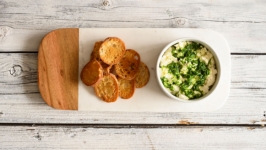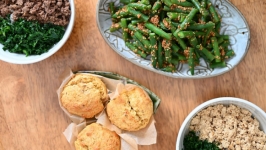Face the Beast
The first time I saw a skinned rabbit, I wasn’t sure I could stomach it. It was several years ago when I came upon them, passing through the kitchen at Fraser Café, where I stopped dead in my tracks at the sight of the furless, pale pink critters laid out on a stainless steel prep table. They had come in whole and unbutchered, the way most chefs prefer. The ears lopped off and the eyes still intact, there was no mistaking the mesh of muscle and sinew of their telltale hindquarters.
At the time, I winced at the thought of eating rabbit, but they weren’t destined for my dinner. Instead I would be serving them. The chefs, brothers Ross and Simon Fraser, had brought them in for our guests that night, unbeknownst to them, as one of the surprise dishes that fell under the mysterious “kitchen’s choice” option.
When it showed up on the pass, the rabbit was utterly transformed. No longer did its round, dead eyes gape at me, the head and limbs now gone. It had been prepared as a roulade, the meat flattened and rolled with herbs before settling in for a roast. It looked and smelled wonderful, but I couldn’t get their naked bodies out of my mind. In a kitchen, where I found myself constantly bumping into the farmers, fishers and foragers who supplied the bulk of our ingredients, that day it was the meat I had to face.
Seeing the rabbits in such a raw and wretched form must have stirred remnants of my sallow, hemp-clad youth, when my vegetarian and later vegan mind was awash with horrific PETA imagery. For years, I had vehemently eschewed meat (and leather footwear), but my pro-animal angst was poorly fuelled by an ill-informed diet of excessive amounts of white rice and Yves Veggie Ground Round. No wonder I lost my grit.
But the kitchens of a chef-run, farmer-supplied restaurant are a far cry from the fast-food outlets that had spurred on my youthful rage. By my 20s, I was overwhelmed by a primal bloodlust (and a rather severe iron deficiency) that had me tucking tail and returning to the carving station. I continued to hop back and forth between knives and forks, dealing with my own omnivore’s dilemma. Now approaching midlife, I’m finding my footing in the middle ground by figuring out how to be an ethical carnivore.
I could just have easily returned to a gustatory path of peace — now is certainly the time to be vegan. The glut of exceptional dining options have easily pushed meat to the outer reaches of my plate and often off it completely, with a moral digestif to boot. Only a handful of incisor-bearing Neanderthals would sneer at chef Michael Frank’s Meatless Monday residency at Citizen, the weekly lineups are a good indicator that they don’t know what they’re missing. And I’m convinced that Pure Kitchen's cauliflower wings would outmuscle the mountains of heartbreakingly premature limbs filling baskets on wing nights across town any day, with even the most devoted carnivore sure to miss the switch after a pint or two.
Then there is, of course, the crowning glory: the excruciatingly talented vegan chef Briana Kim of Café My House, taking top honours at Ottawa’s Gold Medal Plates competition last year. She may have missed out on gold at the nationals, but veg-heads across the 613 will be cheering on their culinary champion for years to come.
All this at a time when Health Canada is poised to release its revamped food guide with a pro-plants makeover. For those who have a tendency to baconize everything, it’s a long overdue wake-up call. Surely, we stand a better shot at a healthier, more sustainable future with more herbivores in our midst.
Does this mean the industrial animal protein complex could finally grind to a halt? Of course, we would all like to see the factory farm turned out to pasture forever, but for those of us not quite ready (or willing) to sheath our steak knives for good, eating meat doesn’t have to contribute to an assembly line of horrors. On the contrary, it might even enable change, but it will require a hard and honest look at the underbelly of what it means to eat animals. Unless you are prepared to move next to an abattoir, the best way to lose your taste for factory meat might be to support those in the meat industry who are working for change — and can guide you in selecting the better beast.
A local butcher is a great place to start. If they are anything like mine, they are a bastion for small-scale farmers who have hinged their livelihoods on the responsible and most humane methods of animal husbandry. Transparency will be one of their tenets.
At my local butcher shop, Muckleston & Brockwell on Beechwood Avenue, there has been, on occasion, a chance to watch Andrew Muckleston working his craft on an entire side of cattle, freshly culled off the pastures of Enright Cattle Co. in Tweed, Ont. — a farm that ought to be the archetype of enlightened agriculture, where you can, while toting around a gorgeous handbag, eat and wear beef that has lived well.
The opportunity to bear witness to the guts of the operation in broad daylight, while asking the butcher some tough questions, should tell you a lot about the integrity of a place, not to mention your own comfort level with what you consume. A butcher worth his salt should be able to tell you the entire life story of each felled beast, a story that should end with "one-bad-day."
And vegans need not get hornswoggled into treating these folks as the enemy. That soy-fuelled spunk would be better served encouraging any and all fang-toothed friends to spend their meat dollars at a restaurant or butcher shop that cares about how the meat it serves was raised and how it ultimately made its way to the plate — and not to scoff at the price and portions. Once they taste meat that didn’t come out of a positively barbaric system, they’ll realize it’s well worth it — and a good indication of how little meat we should be eating in the first place. Your local farmer and butcher would agree: a good piece of meat doesn’t need to hang off the sides of your plate to fill you up. As one market-savvy beef farmer recently told me, a cut “the size of your palm” is about as big as it should get.
No matter where we get our protein, we should push the needle towards more ethical and sustainable meat consumption by facing what we eat — starting with those small, more adorable critters in the meat fridge. Rabbits mature quickly and require considerably fewer inputs to build relative body mass, converting grasses into nutritious and lean protein. Just as their reproduction rate is legendary, so too is the ease by which they can meet their end (perhaps nature’s assurance that rabbits are destined to be someone’s dinner) and it leaves less chance to bungle those final moments. And if Briana Kim could wield the whole bunny handed to her in the black box at the Gold Medal Plates competition in Kelowna, then that’s saying something.
But cuniculture eludes us. On average, Canadians eat less than 25 grams of rabbit a year, instead choosing to ingest almost one thousand times more pork, and even more beef (chicken has them all beat by a landslide). Few of the unsuspecting diners I delivered the rabbit roulade to that evening were thrilled by their dinner and some seemed downright squeamish. Maybe it was the memory of a childhood pet or that their cute quotient is considerably high. Either way rabbits have a way of hopping into our mind’s eye more than the bigger, belchier beasts, making them a little tougher to chew.
When I finally tried the rabbit roulade myself, I found it to be, without a doubt, delicious. The bunny had been led to the broiler with what I felt was an honest homage that left me with untainted blood on my hands and a new motto: if I can’t face it, I don’t eat it. My future might once again fulfill our collective plant-based prophecy, but for now I choose the middle ground, alongside my local butchers, farmers and chefs, who I know will be there to help me meet my meat.













